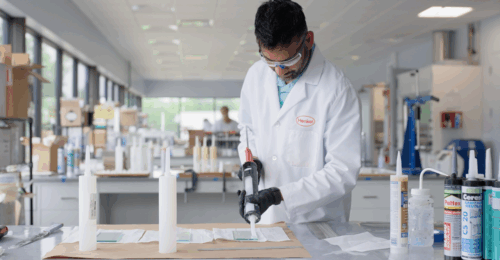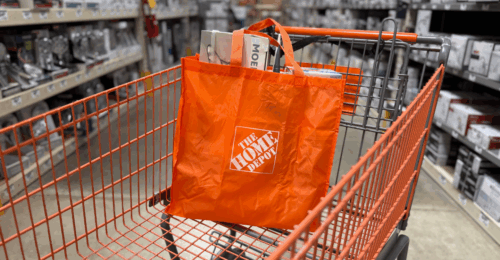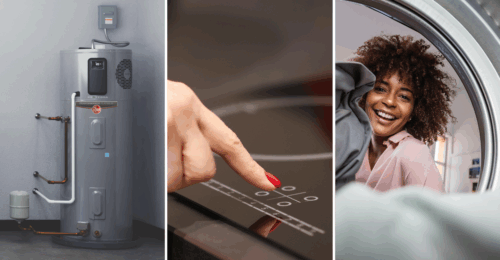Product packaging has come under a lot of environmental scrutiny in the last decade. Packaging is in a difficult position – it’s both critical and temporary. No one knows more about this conundrum than Greg Fornasiero, Director of Packaging Engineering at The Home Depot. We’ve asked Greg to talk to Eco Actions about what The Home Depot is doing to improve packaging and make it more sustainable. With three decades of packaging engineering to reflect upon, Greg is also the perfect person to speak to how far we’ve already come.
EA: What exactly does the Director of Packaging Engineering do for The Home Depot?
GF: I lead the packaging engineering group for The Home Depot’s private brands. We have about 30 associates worldwide, and together, we work to set and enforce packaging standards for all our private brand products.
EA: Can you tell us more about those standards? What do they include, and how do you go about enforcing them?
GF: Sure. We have three areas of focus: performance, value and sustainability. The bulk of what we do is ensuring packaging performs as expected, that it gets the job done. We test all new product packaging to make sure it can get safely through the supply chain to a customer’s home or work site. We send it through ISTA (International Safe Transit Association) testing, drop testing, vibration testing and compression testing. If you think about it, products go through a lot in their journey from creation to destination – even more so now that so much shopping is taking place online – and packaging bears the brunt of that.
The second part of our job is to look at how packaging creates value. We are charged with making packaging better in every way, from protecting products to providing an experience. We question every aspect of packaging. How can we improve it to further reduce damage? Can we make it more efficient to cut down on shipping space and shipping costs and reduce the carbon footprint associated with the supply chain? Can we optimize storage space and costs? Can we make it more efficient and make better use of shelf space in the store so customers aren’t faced with out-of-stock items, and stores don’t lose sales? Can we elevate our packaging to give customers a more frictionless experience and create what we call “a box to enjoy”?
EA: How does sustainability play out as a responsibility for the packaging team?
GF: Officially, we have sustainability goals as a company, such as our sustainable packaging initiative. The Home Depot has pledged to exclude expanded polystyrene (EPS) foam and polyvinyl chloride (PVC) film from private label packaging by the end of 2023. Our team is responsible for ensuring that pledge is met by securing alternative materials. The challenge is not getting rid of something, it’s finding a substitute that is abundant, performs as well and doesn’t cost more. When we commit to doing the right thing, such as removing hard-to-recycle plastics from our packaging, we commit to doing so without increasing customer prices.
Unofficially, we are a team of engineers. We analyze everything for opportunities to optimize, so sustainability is a real motivator. Materials are obviously a big part of that. But it’s not always the things we see and feel that make the biggest impacts. Sometimes, it’s a matter of reducing the size of a package. Shoppers may not even notice the difference. But the overall impact can be enormous, saving material and dramatically decreasing the carbon footprint associated with getting those products from point to point.
Damage is an issue from a sustainability standpoint as well. Anything that gets broken must be replaced, which essentially doubles the carbon footprint. So, we work to design packaging that prevents damage, which takes us back to the testing we talked about before.
EA: You mentioned that sustainability isn’t always something we notice. Can you give us a specific example?
GF: Sure. I’m thinking of our EcoSmart LED light bulbs, in particular. For those who don’t know, EcoSmart is The Home Depot’s private brand of LED light bulbs. This story starts about eight or nine years ago when The Home Depot first introduced an EcoSmart LED bulb. At the time, LED technology was new, and bulbs were expensive at about $50 per bulb. Here we were with a premium light bulb, and they were packaged individually. The packaging needed to not only protect the bulb, but also secure it against theft and match the premium price point.
We had an idea to place the bulb on a pedestal surrounded by a clear case. But we wanted to be as sustainable as possible because LED bulbs were an energy-saving product after all. So, we went with a clear plastic box with a paperboard insert inside that displayed the features. There was even a foil-stamped mirror on the bottom so you could see the reflection of the bulb inside the box. It was cool, but it was hardly on the shelf before we were analyzing it to try and make it more efficient.
As products evolve, we respond. So, fast forward a few years to when prices of LEDs decreased. Bulbs became a lot more robust, which meant that we could adapt our packaging to be less robust. We could pack multiple bulbs in a package. Eventually, we saw opportunities to remove all the plastic from the category, and we got to a point where the EcoSmart packaging was 100% recyclable. We also kept pushing the packaging to get smaller and more efficient.
Between 2016 and 2018, we worked to optimize the EcoSmart multipacks. Again, the change is one that most customers might not even notice. But we were able to manipulate the internal configuration in a way that would decrease space without sacrificing product safety. As a result, we decreased the overall package size by 20%. That reduction in size translates to 43% less material and 30% less cube (shipping capacity). That really adds up. When you consider the scale at which The Home Depot operates, we’re talking about removing entire container ships from the supply chain.

Comparing the first-generation EcoSmart LED bulb packaging to today’s iteration shows just how far we’ve come. Today’s packaging uses 91% less material and zero plastic and is 100% recyclable.
EA: You mentioned that EcoSmart is one of The Home Depot’s private brands. How does this relationship influence sustainability in packaging?
GF: Sustainability and private brands are closely connected. Many of The Home Depot’s sustainability initiatives, including packaging, start with private brands because they are what we can control. EcoSmart is just one example. If you look at the changes we’ve made to the EcoSmart packaging over the years, you’ll see a journey with parallel paths where product and packaging innovations go hand in hand. It’s one reason packaging engineers are always busy.






